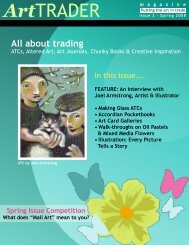Beginner's - ArtTrader Magazine
Beginner's - ArtTrader Magazine
Beginner's - ArtTrader Magazine
Create successful ePaper yourself
Turn your PDF publications into a flip-book with our unique Google optimized e-Paper software.
Art TRADER<br />
m a g a z i n e<br />
Canines<br />
Canines have a longer, more rectangular shape to their muzzles. Of course, some<br />
of the more mutated breeds of dogs - chihuahua and boxers for example, have far<br />
shorter and rounder muzzles. Their ears either are erect pointing directly upwards, or<br />
flop comically beside their face. Their eyes are smaller in proportion to their body size,<br />
although it should be noted that some canine species are nocturnal (fox and coyote for<br />
example). Some species of wild dog and domesticated breeds sport a ruff of fur about<br />
their face and neck. These are not quite as defined as their feline cousins, but should<br />
not be overlooked.<br />
PREY<br />
Rodents/Lagomorphs<br />
Rodents and Lagomorphs are about as closely related as cats and dogs. They have<br />
large, round, dark eyes identifying their largely nocturnal lifestyle and more pronounced<br />
eye sockets. Their ears are quite large in proportion, giving them good hearing - all<br />
the better to hear those predators! Their snouts are quite long and pronouced but their<br />
mouths are quite small. Eyes are set back closer to the ears, giving them “all-round’<br />
vision. Note the difference in noses from the carnivores above - these prey species<br />
have a “V” shaped nose, the nostrils rimmed with pink. Features to look for when<br />
drawing rodents and lagomorphs:<br />
• Eye size - big or small? Most rodents have quite large eyes.<br />
• Cheeks - ruffs/pouches? Rodents store their food in cheek pouches, which can be<br />
characterized by tufts of fur.<br />
Ungulates<br />
Hoofed animals are prey species of the larger carnivores and as such need good<br />
peripheral vision. Their eyes are set back in the sides of their head, near the base of the ear and at a<br />
distinctly different angle to that of a carnivores. Their snouts are quite long, their mouths small. They also<br />
have fleshy lips, used to pull leaves from trees or grass. Their ears are set high on their head. Features<br />
to look for when drawing rodents and lagomorphs:<br />
• Nostrils or Dy Noses? Many ungulates have two separate nostrils, set to either side of their snout and<br />
rimmed with pink. Some, however, like deer and antelopes, have actual “dry noses” not unlike those<br />
of the carnivores.<br />
• Head adornments? To protect themselves and help defend mates, many ungulates<br />
sport defensive measures in the form of horns or tusks. Look for where these<br />
attach to the body and the form they take. They should be sketched in now if<br />
they’re not already.<br />
• Ear shape? Ungulates have longer, pointed ears. Some, like horses, point directly<br />
upwards, whereas goats and deer may rest at right angles to the cheeks or droop<br />
downwards.<br />
• Lips - narrow or wide? Ungulates have fleshy lips - browsers (tree eaters) have<br />
narrower lips often with prehensile properties, ideal for plucking. Others, like the<br />
white rhino which is a grazer, are much wider and act more-or-less like a<br />
lawnmower. Study your reference and imagine how it likes to dine. Also, look for<br />
tongues. Giraffes, for example, have very long tongues which they use to denude<br />
branches.<br />
• Pupil shape and size? Are the eyes large and dark and limpid like a deer’s or are<br />
the pupils narrow, evil, horizontal slits like a goats?<br />
-61-




